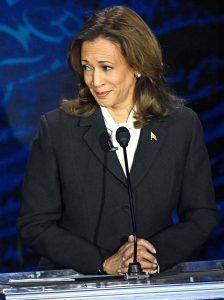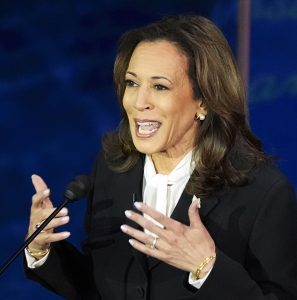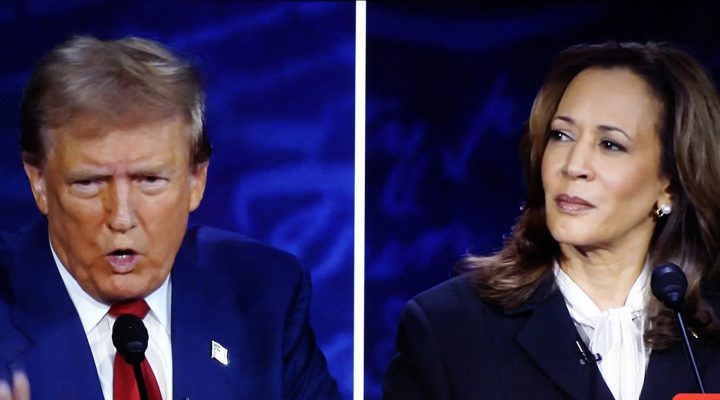The words flying in the presidential debate between Donald Trump and Kamala Harris were fierce, but the center of attention should be the visual rhetoric of Trump’s and Harris’ faces, with special attention to how images of their faces are circulated.
For affect theorist Silvan Tomkins, the face reticulates us into a social body. The face marks us and shows us who we are. The nonverbal aspects of the face often communicate the real message. If you want to understand a person, the best clues are in the facial expressions.
The faces tell us what we need to know about both Trump and Harris.
Trump’s face
The emotional importance of Trump’s face demands attention in and of itself. The looks on his face offer insight into the affective dimensions of his discourse. The nonverbal performances of his face — the redness, the anger and even the confusion — made his words futile and meaningless.
Perhaps no politician ever has understood the significance of the face as a rhetorical tool as well as Trump. According to Chuck Todd, Trump is sensitive to how his face communicates. Trump will, after taping a television interview, rewatch the tape in the studio with the sound off, studying his own face.
“Perhaps no politician ever has understood the significance of the face as a rhetorical tool as well as Trump.”
The Trump script — the tickertape of words coming out of his mouth — is an important part of the Trump emotion machine but is not actually sufficient for his political purposes. Ideological grenades and outright lies are only part of Trump’s arsenal. He mobilizes other emotions with his looks.
Trump’s face always has been a major part of his performance. He stares at his audience almost constantly. There never is a lowering of the gaze by Trump. He thinks of lowering the gaze as a sign of weakness and shame.
Trump has carefully produced an image of himself as a dominant male, a controlling person. His official portraits show him unsmiling, rigid, glaring. The image he wants to project is that of a no-nonsense and completely in-charge man. Photos often show him with a bit of a smirk at the corner of his mouth. You almost never see any image of Trump smiling. He once told the media, “I never joke.”

Donald Trump speaks during a presidential debate with Kamala Harris at the National Constitution Center, Tuesday, Sept.10, 2024, in Philadelphia. (AP Photo/Alex Brandon)
According to rhetorical and affect theorist Donovan O. Schaefer: “When Trump was caught on tape practicing a speech on his way to address Congress in March 2017, pundits were surprised that he seemed to be rehearsing the facial expressions he would use to amplify the impact of his words. We see Trump cycle through three practiced expressions: a sneer; an almost-ecstatic, ferocious pieta in which Trump stares upward with an open-mouth grimace; and a sort of triptych in which Trump mimes three glares in rapid succession, bobbing his head and sharpening his stare with each beat.”
As an actor, a television creature, Trump knows the root of his power is his face. The visual rhetoric of Trump’s body — “controlling, coercive and conceited, a combination of traits that embody white privilege and hypermasculinity” — is a necessary augmentation to the Trump script.
Trump’s nonverbals include his hair, signature orange glow, and attire. His overall look reflects white privilege, elitism and “I’m smarter and tougher than you.”
During his first campaign for president, Trump’s demeanor was that of the court fool of the Medieval era. He acted out the role of celebrations known as the “feast of fools” and “feast of the ass” which opposed all serious official feats and elite political ceremonies. According to the Russian literary scholar Mikhail Bakhtin, the feasts “marked the suspension of all hierarchical rank, privileges, norms and prohibitions.”
Trump played this role to the hilt as a candidate. As Bonnie J. Dow puts it, “Trump communicated most effectively through hyperbole, untruthful and often incoherent claims, and threats against his opposition.”
Robert L. Ivie calls Trump’s rhetoric “carnivalesque.” Ivie says: “It plays to a fantasy of bootstrapping individualism and unfettered capitalism. It dominates the public agenda in a mercurial display of political clownery.” And “his act is political theater.”
The closest contemporary event most like the “feast of fools” is a Trump campaign rally. This is an unruly affair where Trump and MAGA “enjoy the cruelty” of degrading and debasing the political elite.
“The closest contemporary event most like the ‘feast of fools’ is a Trump campaign rally.”
Trump plays the Medieval fool perfectly. Fools, Bakhtin says, “exercise the right to confuse, tease and hyperbolize life; the right to parody others while talking, the right not to be taken literally … the right to rip off masks, the right to rage at others with a primeval (almost cultic) rage.” Trump plays this role as a candidate. He is a repulsive, know-nothing clown begging for the love of all Americans. He mocks everyone, insults everyone, condemns everyone.
In The Twitter Presidency, Brian L. Ott and Greg Dickinson, argue: “The embodied examples of Trump’s foolery are endless. Best known, perhaps, is his mocking of a disabled reporter. In endlessly shared video clips from CNN and other news sources, Trump going into character as the disabled reporter waves his arms uncontrollably though held tight to his body, his voice suddenly an octave higher and stuttering.”
Trump speaks and acts like a WWE wrestler in a suit. He performs for his followers the kind of “creepy” aggression that characterizes misogynistic masculinity. His body is performing the rhetoric, his face enacting masculine rage.
In the debate with Harris, Trump lost self-control of his carefully orchestrated actor’s face. He couldn’t conjure his usual intimidating “I’m in charge” sneers, glares and stares. Instead, we saw anger, confusion and a bit of a little boy who wants to be anywhere except on a stage where he is being brutally attacked.
The looks on Trump’s face bore witness against him, proclaiming the untruthfulness of his statements and the shame of his wild and misleading rhetoric.
What had worked for Trump in the past, especially in his debate with Hillary Clinton, was a dismal failure in the face-off with Harris. His acting skills failed him. His facial expressions deserted him.
“His acting skills failed him. His facial expressions deserted him.”
Harris threw him off his game within the first 4 minutes of the more than 90 minutes of debate. She reduced the power of Trump’s face to pain, anguish, anger and doubt. His famous embodied rage failed to show him as powerful and invulnerable. Instead, he looked uncertain and weak.
Harris’ face
In the moments ABC provided viewers with a split screen, Harris’ facial expressions were the opposite of Trump. She didn’t appear angry. At times she had a look of painful concern for Trump’s rambling rhetoric. In other moments she leaned her head back and took a breath looking to the sky in a motion as if an eyeroll was begging to make an appearance. And at other times, she had a look of incredulity that said, “Bless your heart” without saying it.

Kamala Harris listens as Donald Trump speaks during a presidential debate at the National Constitution Center in Philadelphia September 10, 2024. (Photo by SAUL LOEB/AFP via Getty Images)
More than once, her face shouted, “What in the hell is this man talking about?”
Someone on Facebook suggested Harris had the kind of looks a teacher gets when listening to a student attempt to explain an assignment he has not read: Raising her eyebrows, shaking her head, letting out the occasional chuckle, resting her hand on her chin and rapid blinking.
With her relentless strategy of “baiting” Trump in the areas where he is the weakest, she short-circuited Trump’s usual ability to intimidate. He rarely looked at Harris, never called her by her name, and stared into space. He seemed as if he didn’t quite know what to do with a woman he had called of “low I.Q,” “stupid,” and unable to put two sentences together in a debate.”
As she spoke, Harris’ face seemed warm, genuine, approachable. In some sense, I thought she completely disarmed Trump when she walked onto the stage prior to the debate, went over to Trump, offered her hand, smiled and said, “Hi, I’m Kamala Harris.”
It was the first time the two ever had met and Harris already had the upper hand with her smile and warm greeting. A surprised Trump’s response was not audible, but he seemed to say something similar to Job meeting God, “I had heard of you by the hearing of the ear, but now my eyes see you.”
Trump previously told Elon Musk of Harris: ““She looks like the most beautiful actress ever to live. Actually, she looked very much like a great first lady, Melania. She didn’t look like Kamala.”
He was referring to an illustration of Harris on the cover of Time magazine, which he called a publicity “free ride.” He meant it as a slur but once again called attention to his fixation with the appearance of women. Maybe Trump’s infamous disrespect for women addled his brain during the debate.

Kamala Harris speaks during a presidential debate with Donald Trump at the National Constitution Center in Philadelphia Sept. 10, 2024. (AP Photo/Alex Brandon)
Perhaps the warmest part of Harris’ performance were the moments when she smiled — at times almost in condescension — at some wild Trump claim. For example, when Trump repeated a rumor from the web about migrants eating dogs and cats in Springfield, Ohio, Harris had trouble not laughing out loud.
In fact, Harris did manage a laugh or two. This was delicious irony because one of Trump’s early clumsy attempts to attack Harris was to make fun of her laugh. Trump labeled her “laffin’ Kamala Harris.” Later, at a Michigan rally, Trump went further: “You ever watched her laugh? She’s crazy. You know, you can tell a lot by a laugh. She’s nuts.”
Trump missed his target. Harris may get the last laugh, because her genuine smile and laughter — lighting her face with joy — may be a refreshing change for voters tired of endless lies and conspiracy theories.
She who laughs last laughs best, huh?
Everything we needed to know was in the faces of Trump and Harris. Trump was scowling, angry, red-faced, uncertain. Harris was relaxed, smiling, laughing and cutting Trump down to size with one “teacher” look after another at a poorly prepared student.
Rodney W. Kennedy is a pastor and writer in New York state. He is the author of 11 books, including his latest, Dancing with Metaphors in the Pulpit.
Related articles:
As Trump praises Orbán, new polling data show who supports authoritarian rule in America
A picture is worth a thousand words, but so is a video | Opinion by Harold Ivan Smith


